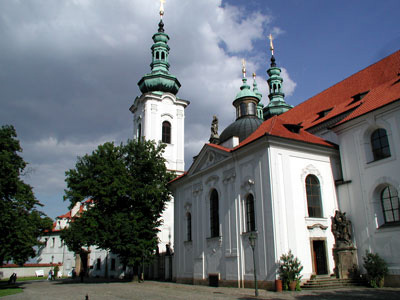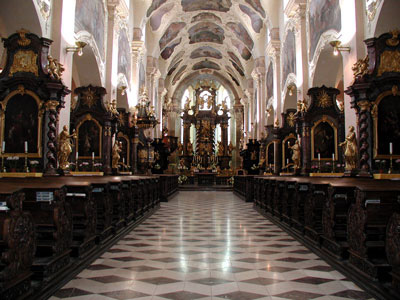 |
||||||||||
 |
||||||||||
|
1350: The Basilica of the Assumption of Our Lady, Strahov Monastery, Prague, Czech Republic Mystery Worshipper: Og the King of Bashan, and his most beauteous Queen. The church: The Basilica of the Assumption of Our Lady, Strahov Monastery, Mala Strana, Prague 1, Czech Republic. Denomination: Roman Catholic. Comment: We have received a comment about this report. Also see the discussion thread on our Ecclesiantics bulletin board. The building: A wonderful late-Baroque fantasia. The original basilica was built in the 13th century, but the current incarnation dates largely from 1742, after the French decided to use it for target practice during the bombardment of Prague. According to the website, the nave is 63 metres long, 10 metres wide, and 16 metres high; it feels long, but relatively narrow and intimate inside. There's an enormous Baroque organ in the west gallery, and a stunning high altar in dark wood, marble and gold. Frescoes cover the nave ceiling and apse, and there's an altar against every pillar, not in side chapels but all visible at once. However, it was anything but solemn. Prague statues generally look as if they can barely keep still, and here there were golden saints and bishops dancing all over the church! The Queen was uncharacteristically pleased with the nave altar, the large rood making a rather better focus than the cluttered high altar. The church: The church has a regular parish congregation, but is primarily for the use of the Royal Premonstratensian Canonry of Strahov, one of the oldest communities of Premonstratensians in the world. The order's five main ends are apparently "the singing of the Divine Office, the spirit of habitual penance, a special devotion to the Holy Eucharist, a special devotion to the Blessed Virgin, and zeal for the salvation of souls." The monastery has been active more or less continually since 1143, despite being burnt down by Hussites in 1420, being briefly shut down in the Emperor Joseph II's secularisation reforms in the 18th century, and officially closed between 1951 and 1989 by the Communists. The neighbourhood: The church is part of the monastic complex of buildings. This includes a modern cloister, peaceful gardens, an interesting art gallery, an exhibition of Premonstratensian tat (including a four-pointed white biretta, and many white cassocks) an astounding Baroque theological library, summer and winter refectories for the monks – and, very interestingly, a pivnice (beer house) which sells the excellent local monastic brew, a dark, strong, sweet Czech beer. The librarian informed us in no uncertain terms that she was shutting early, so we were forced to spend extra time sampling the beer, which goes by the name of St Norbert. Such a sacrifice! The wider immediate neighbourhood contains Prague Castle and St Vitus' Cathedral, and its picturesque cobbled streets are moderately besieged with tourists. The monastery is thus a welcome oasis. The cast: Unfortunately, I couldn't find out the individual names of the monks! There were only about seven in total attending this mass – about four in the quire, one celebrant, one deacon and one sub-deacon. Plus a few assorted taperers, and a young thurifer who looked as if he was in his very early teens. The date & time: Thursday 21st September 2006, 6pm. What was the name of the service? Evening Mass. How full was the building? About one-third full, including monks. There were about 40 people, mostly Czech as far as we could tell, including an impressive number of people in their teens, and twenty-somethings. Despite the imposing size of the church, there aren't that many pews! About six or seven monks were there, three or four of whom acted as the choir. Did anyone welcome you personally? A youngish monk stood by the door and looked frightening for the American tourists, but looked rather more friendly and opened the door for us when we made it clear that we weren't just going in to gape at the architecture. Was your pew comfortable? Not bad. It was beautifully decorated in Rococo style, which contained lots of smooth curves to support one's back! How would you describe the pre-service atmosphere? A little chattering, which dwindled to rather more hushed awe as the organ prelude swelled, the incense filled the nave and the altar party made its way from the vestry. What were the exact opening words of the service? It started with a hymn, or rather with part of a hymn – two hymns were stretched out over the whole service. We could work out the words for "Jesus Christ" and a few of the others, but other than that, we had little idea of what we were singing about. Funnily enough, the King found this quite a liberating experience. What books did the congregation use during the service? A Czech hymn book was handed out, and there were Novus Ordo service books in the pews. There was none of the flurry of paper familiar from Anglican parish services. What musical instruments were played? A very well-played 18th century organ, with excellent improvisation on the hymn tunes before and after the service. Lots of good plainsong from the celebrant and deacons. interestingly, the eucharistic prayer was also sung accompanied by slightly eerie harmonies on the organ. Apparently the monastery is very proud of its musical traditions, and claims that Mozart played the organ when he visited Prague in 1787. The congregation were a little reticent with joining in on the hymns, but rather better than a lot of Catholic congregations! Did anything distract you? For such a madly ornate church, it was much less distracting than it might have been. Indeed, the joy of a church like this is that even if one's eyes do wander during the liturgy, the rich decoration would always be making a particular theological point, or telling a story. However, the Queen did suddenly notice half way through the service that the pillars of the nearest altar did a 180 degree corkscrewing twist at the bottom. Was the worship stiff-upper-lip, happy clappy, or what? This was indeed Novus Ordo, but the overall feel was more 1690s than 1960s. It was actually quite possible to understand where we were in the service simply by following the rhythms and cadences of the lines, despite our totally limited Czech! In terms of tat, all the clerics wore white cassocks in the Premonstratensian way, with cottas on top for the acolytes. The celebrant, deacon and subdeacon were also wearing a red chasuble or red dalmatics. The other monks wore red stoles and at one point one of them was wearing what the Queen thought was a large pashmina, except holding it up to his face. The King informed her with some condescension that it was a scapular veil, used to transport the most precious body of our Lord. However, we sadly didn't get to see the white biretta in action, as it was kept in a glass case in the visitor's entrance. Marvellous dignified stuff, generally.  Exactly how long was the sermon? 8 minutes. On a scale of 1-10, how good was the preacher? 7 – Sadly, neither of us could make out very much of the content of the sermon. The priest's delivery appeared good and clear, although he seemed increasingly apologetic as he delivered it, which was rather out of character with the rest of the liturgy and the surroundings. Oddly, though, it was delivered from the front, while the readings were given from the pulpit. In a nutshell, what was the sermon about? Unfortunately, I couldn't tell you! Which part of the service was like being in heaven? Most of it, according to the Queen! The main joy was seeing such an un-English church in action. The counter-reformation churches of Prague can easily seem ridiculous when you visit as a tourist; the altars can seem overblown, and the gilding can look tawdry. But the style really came into its own with a service that suited the surroundings, and an opportunity to use the art for devotion rather than just sightseeing. If the King had to choose one moment specifically, it would be the moment when the procession began, and we realised this wasn't going to be just a rushed low mass... quite the opposite! And which part was like being in... er... the other place? Well, I suspect that the potted spider plants on the altars probably resemble the décor of the infernal regions quite closely. And in the midst of dancing cherubim and ageless seraphim, there winked obscenely a bright red electronic digital hymnboard. What happened when you hung around after the service looking lost? The end of the service was not easy to pinpoint. About half of the congregation left before the Angelus, although 10 or so of the younger people were still standing outside talking to one of the monks when we came out. Others, like us, snuck out before the end. The chattering group all gave us a big smile, but we felt a little scared of joining in the conversation in Czech! Nevertheless, we got the impression that there was a very warm community of all ages here. How would you describe the after-service coffee? Sadly, no coffee, but there was that brewery on site. It smelt fantastically of hops (like Horlicks and warm bread) and quite made up for the lack of coffee! How would you feel about making this church your regular (where 10 = ecstatic, 0 = terminal)? 7 – Since it would involve not only crossing the Tiber but also travelling across the continent, probably not. But we would certainly come again were we in the area, and it's wonderful to see that daily high-quality musical liturgy isn't the exclusive preserve of English cathedrals. Did the service make you feel glad to be a Christian? Well, the Queen ain't. She started off feeling rather sorry for the Hussites, but left this church with more sympathy for the counter-reformation project. The King of Bashan left very much on a spiritual high, not completely down to the effect of the monastic brewery. What one thing will you remember about all this in seven days' time? The dancing saints! |
|
|
||||||||||||||||||||||||||||||||||||
| More Mystery Worshipper reports | |||||||||||||||||||||||||||||||||||||||
 |
|||||||||||||||||||||||||||||||||||||||






